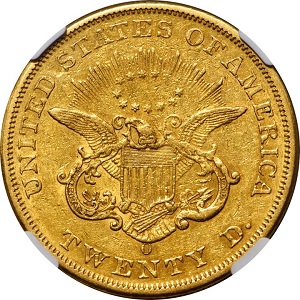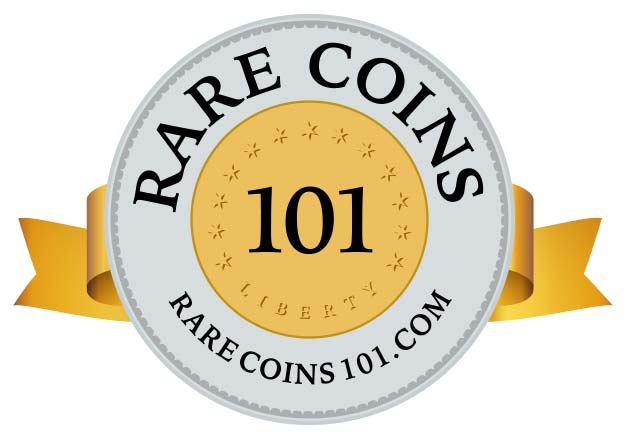1850-O Coronet $20 Double Eagle
The California Gold Rush attracted thousands of adventurous “49ers” westward with dreams of striking it rich. Within a matter of months, the gold fields bore vast fortunes of the yellow metal, heretofore unseen in American history.(1)
With the huge influx of gold, it became clear coins carrying a higher face value were necessary. On March 3, 1849, legislation was passed authorizing the $20 double eagle, the largest circulating denomination ever issued by the United States Mint. The same law also gave birth the diminutive gold dollar coin.
Several pattern double eagles were struck in 1849, but all were destroyed except one specimen that today resides at the Smithsonian Institute. It wasn’t until 1850 when James Longacre’s Coronet double eagle design hit the streets of America.(2)
Gold from the California hills was steamboated to New Orleans and Philadelphia for coinage, with the lion’s share finding its way to the City of Brotherly Love.(3)
Much of the bullion was converted into the newly approved $20 double eagle denomination, resulting in a first year mintage of 141,000 for the New Orleans Mint. From 1851-1853, the Louisiana mint delivered a considerable 576,000 cumulative mintage of double eagles.(4)
After the San Francisco Mint opened in 1854, bullion shipments to New Orleans dropped dramatically, as did double eagle production accordingly. The double eagles bearing the “O” mintmark from turbulent pre-Civil War years of 1854 to 1861 are some of the rarest, most valuable trophies in United States numismatics today.(5)
The entire 1850-O double eagle output circulated extensively along the Mississippi River trade routes and throughout the South. Many 1850-O examples were exported to London and other overseas destinations, where they were melted. These factors explain the acute shortage of Mint State specimens.(6)
The modern-day collecting community views the 1850-O Coronet double eagle to be a scarce date, but not a particularly rare coin. However, it is a very popular alternative for double eagle devotees and students of history who yearn for antebellum coins from the legendary New Orleans Mint, but cannot afford the ultra-rare “O” dates. It’s status as a first-year issue and relative ease of collectability has catapulted the 1850-O to impressive heights.
| Estimated survivors in all grades: 626 ?
The survivor estimate from PCGS represents an average of one or more experts' opinions as to how many examples survive of a particular coin in all grades. Survival estimates include coins that are raw, certified by PCGS, and certified by other grading services. Learn more at PCGS. |
| PCGS Rarity Scale: 5.7 ?
The 'PCGS CoinFacts Rarity Scale' assesses the relative rarity of all U.S. coins, based on estimated surviving examples. The scale runs from 1.0 to 10.0. The higher the number, the rarer the coin.
Learn more at PCGS. |
| Click HERE to check for availability on eBay** |
Preview of eBay selection:
 |
 |
| Trendline Avg = 22.81 | BETTER |
Historic Value Trend Charts:
| Last updated 10-9-24 | Return to Key Date Coin List | |
| Compare to Common Date Coin of Same Type | ||
|
|
||
| Download Charts to Your Computer | ||
Sources
1. NGC. Liberty Head $20 (1850-1907).
2. Bowers, Q. David. The History of United States Coinage. Los Angeles, CA: Bowers and Ruddy Galleries, Inc., 1979.
3. Stack's Bowers Galleries. 1850-O Liberty Head Double Eagle. Aug 2022 Auction.
4. Heritage Auctions. 1850-O $20. Aug 2017 Auction.
5. Stack's Bowers Galleries. 1857-O Liberty Head Double Eagle. Apr 2022 Auction.
6. Stack's Bowers Galleries. 1850-O Liberty Head Double Eagle. Aug 2022 Auction.
Many very fine coin dealers sell on eBay. At any point in time, there may be over one million search results for United States coins. This includes quite a few of the recommendations on our Key Date Coin List.
If you’re thinking about purchasing a rare coin, eBay is certainly worth a look. For your convenience, the links from this site to eBay are coded to bring up only coins certified by PCGS and NGC.
As is always, always the case, never buy a valuable coin from a seller whose trustworthiness cannot be verified. Learn more about this at our chapter Best Places to Buy Coins, which also has a section on doing business on eBay.
In the interest of full disclosure, Rare Coins 101 receives a small commission anytime someone connects to eBay from this site and purchases something.
Coin images by Stack's Bowers Galleries.


